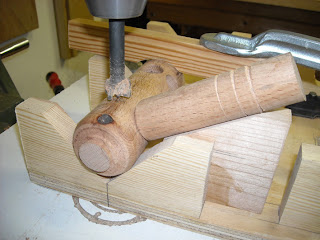It is now holiday period in the Netherlands and I thought it might be interesting to show some holiday pictures of our visit to Sweden a few years ago. One of the main attractions was the Vasa Museet in Stockholm. In this impressive museum an original wooden warship from the 17th century is shown (which sank in 1628 on its maiden voyage) including all the related finds.
This photo does not do justice to the overwhelming magnificence and size of the Vasa.
As the Baltic sea consists of brackish water, no woodworm is found. Hence, everything of wood was preserved while most iron items have rusted away. Among the items found in the Vasa are many woodworking tools used in shipbuilding. Also some shipbuilding techniques are on display at the museum. The next series of photos will give you an impression of the ship and its tools, of which many are identical to medieval (and modern) ones.
A 'small' clamp used in boatbuilding. It is secured with a wedge at the end.
A mallet, brace and a moulding plane
Two different smoothing planes and two rules.
A brace and a pot for something.
The shipwrights toolchest. The wooden staves are handles for adzes
.
Rule, universal bevel, a mallet, braces and awl handles (the oval things), a grease box.
Some boxes and a twine spool.
A square, saw handle, chisel handle, a brace and a smoothing plane.
Braces and a wooden mallet,. At the end also an auger handle.
Again, rule, universal bevel, awl handles and mallet.
The following photos are reconstructed tools, based on the finds.
Auger and types of pins used in boat construction.
Saw, squares and compass.
Several plane types, a chalk line, gouge and compass.
This type of place is typical Dutch and called a 'gerfschaaf'.
Building of the Vasa was overseen by Dutch shipbuilders.
Adzes and axes.
Chisels and gouges, a mallet and a brace.
The following photos show some shipbuilding scenes.
Set-up for hollowing out the masts.
The saw pit.
Set up for bending planks using steam or fire.







































